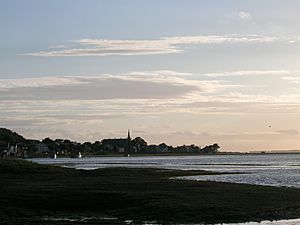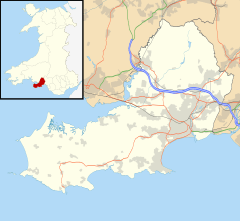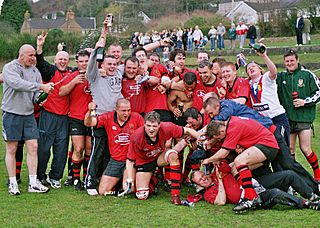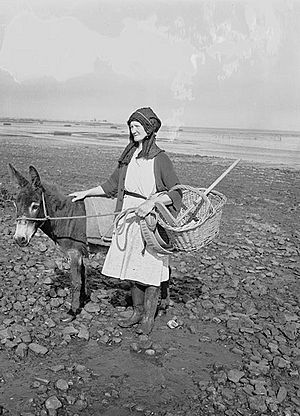Penclawdd facts for kids
Quick facts for kids Penclawdd
|
|
|---|---|
 |
|
| Population | 3,635 (2011) |
| OS grid reference | SS549956 |
| Principal area | |
| Ceremonial county | |
| Country | Wales |
| Sovereign state | United Kingdom |
| Post town | SWANSEA |
| Postcode district | SA4 |
| Dialling code | 01792 |
| Police | South Wales |
| Fire | Mid and West Wales |
| Ambulance | Welsh |
| EU Parliament | Wales |
| UK Parliament |
|
| Welsh Assembly |
|
Penclawdd (which is Pen-clawdd in Welsh) is a village located in the northern part of the Gower Peninsula in Swansea, Wales. It's well-known for its local cockle industry, which has been important for many years, even since Roman times.
Penclawdd is one of the bigger villages on the Gower Peninsula. Part of it sits high up, giving amazing views over the Loughor estuary and the countryside. The main part of the village stretches along the edge of the estuary. Because it's so close to the water, Penclawdd is home to lots of wildlife, including many birds and wild horses that roam the estuary.
Contents
A Look Back: Penclawdd's History
Until the late 1800s, Penclawdd was a busy sea port. It had a canal that connected to the Burry River. The village was famous for coal mining and its factories that worked with tinplate, copper, and brass. These factories were run by the Cheadle Copper Company.
At one time, Penclawdd had many shops, including twenty grocers, three butchers, and three drapers. There were also four fish and chip shops, eleven pubs, and even a cinema. Today, three chapels and a church still remain. The village also had a busy railway station, and you can still see the original platform today. A chapel built in 1807, called Hermon Chapel, was used to help ships find their way through the estuary.
Around 1800, a man named John Vivian from Truro, Cornwall, became a manager at the copper works in Penclawdd and Loughor. His family, the Vivian family, later ran large copper businesses around Swansea. They helped Swansea grow into a big city during the 1800s.
Secret Tests During World War II
During World War II, something secret happened near Penclawdd. On October 28, 1942, a plane flew over the Burry estuary and dropped a bomb. Local people didn't know it, but this was part of the army's experiments with biological weapons.
The area was already used for testing weapons, like mustard gas, so the bombing wasn't unusual to residents. For this test, the bomb contained a small amount of liquid anthrax spores. It was dropped on the sandy ground of the Burry Inlet, near sixty sheep tied up for the experiment.
Two of the sheep died from anthrax, and others got sick but recovered. All the sheep that survived were later put down and buried. Scientists thought the tides would clean the land, so no warnings were given to the public. Other anthrax experiments then moved to a different location. The people of Penclawdd didn't know what had happened in their area.
What Happened After the Tests?
It wasn't until 1982 that local rumors about the bombing became public. A local Labour Party secretary, Keith H. Hopkins, asked for soil tests, information about any anthrax infections in animals or people, and a public investigation.
In January 1987, the government finally confirmed that the estuary near Penclawdd was used for anthrax testing during the war. The records about these tests had been kept secret until 1975. After the public confirmation in 1987, the records were made less secret, but they weren't fully public until 1999.
Apart from work carried out within the then chemical defence experimental station, Porton Down, a device containing anthrax was tested on the beach at Penclawdd, South Wales, in 1942. Investigations subsequent to this trial revealed no evidence of any residual contamination.
At the time of the experiments, scientists believed the tides had "effectively decontaminated" the whole area. However, local people were not always convinced. When many cockles died in the estuary in 2009, it brought up the debate again about whether the area was still affected by anthrax. The local MP, Nia Griffith, asked the Ministry of Defence for answers. They repeated that there was no lasting contamination because the area was washed by the tide.
Penclawdd Rugby Club
Penclawdd RFC, also known as the Donks, has a long history in rugby union. The club officially started in 1888, but rugby was played in the village even earlier, around 1880. This was the same year the Welsh Rugby Union was founded. In its early days, the club didn't have a permanent field. They played on any suitable ground they could find in the village.
Haydn Tanner is one of the club's most famous players. He played for Wales and the British Lions in 1938. Another famous Penclawdd player, Willie Davies, also played for Wales. He later played rugby league for Bradford Northern in the 1930s and 1940s. He won the Lance Todd Trophy in 1947 for being the best player in the Challenge Cup final at Wembley. He also represented Great Britain in rugby league on a famous tour to Australia in 1946.
The club is still active today. They recently celebrated 125 years of rugby in Penclawdd. The first team now plays in the Division 2 South West league of the WRU. The second team plays in the Swansea and district league, and the youth team plays in the Osprey rugby trust leagues.
Tasty Local Foods
Penclawdd is very famous for its cockle industry. Collecting cockles has been a part of life here since at least the Roman period.
Cockles are gathered from the large sandy areas in the Burry Estuary. The cockles collected here are sold all over the world. Until the 1970s, collecting cockles was usually done by women. They used hand-rakes and riddles (which are coarse sieves) and often had help from donkey carts.
The cockles used to be prepared in small, family-owned factories. While the Penclawdd factories are no longer there, some still exist in the nearby village of Crofty. Today, most of the harvesting is done by men, often using tractors or Land Rovers. The cockles are then processed in two large, modern factories in Crofty.
Penclawdd cockles are often linked with Swansea Market, where many stalls still sell them. You can buy them in shops and supermarkets across Wales, but most are sent to other countries in Europe.
Other tasty local foods include laverbread and salt marsh lamb. Laverbread is made from laver seaweed that is washed and boiled. It's often eaten dipped in oatmeal and fried with bacon. Salt marsh lamb comes from sheep that graze on salty marshlands, giving the meat a special flavor. You can find these and other examples of Welsh cuisine at the award-winning local Penclawdd produce market.
Famous Faces From Penclawdd
The famous composer Karl Jenkins was born and grew up in Penclawdd.
See also
 In Spanish: Penclawdd (Pen-clawdd) para niños
In Spanish: Penclawdd (Pen-clawdd) para niños





